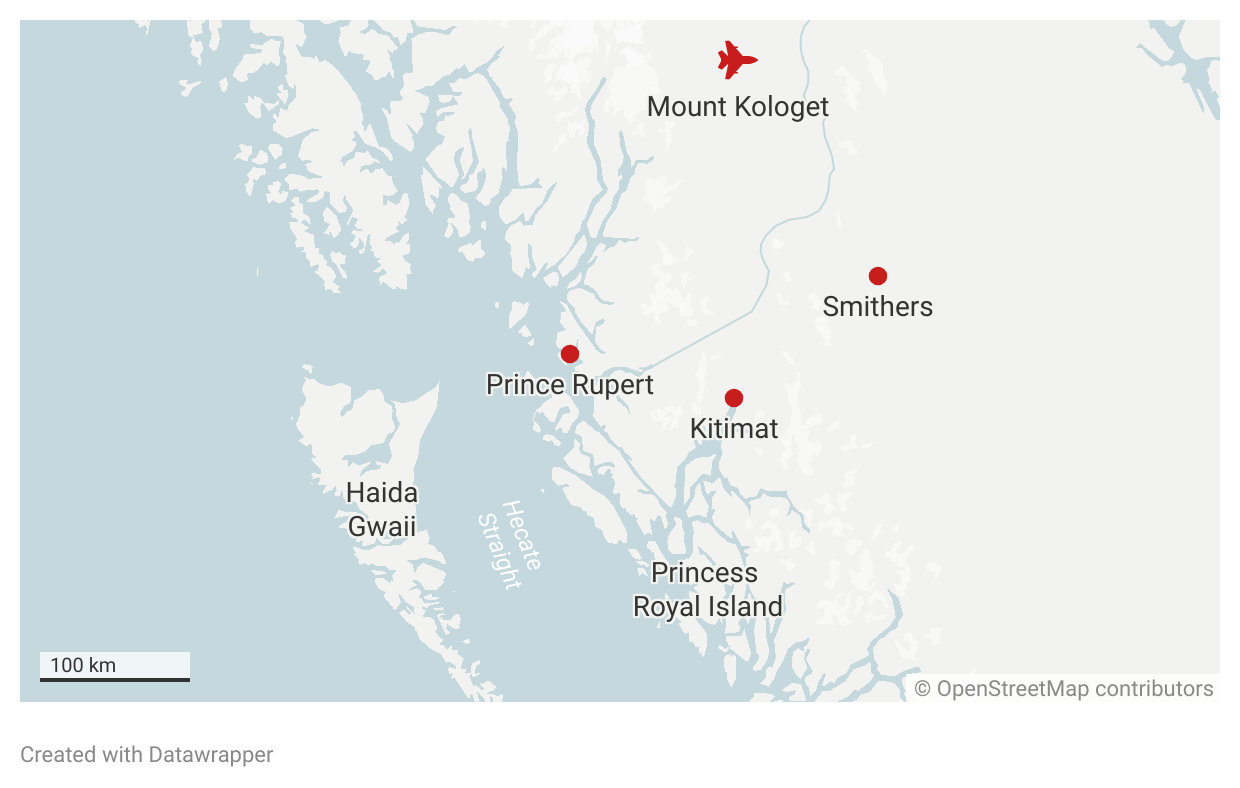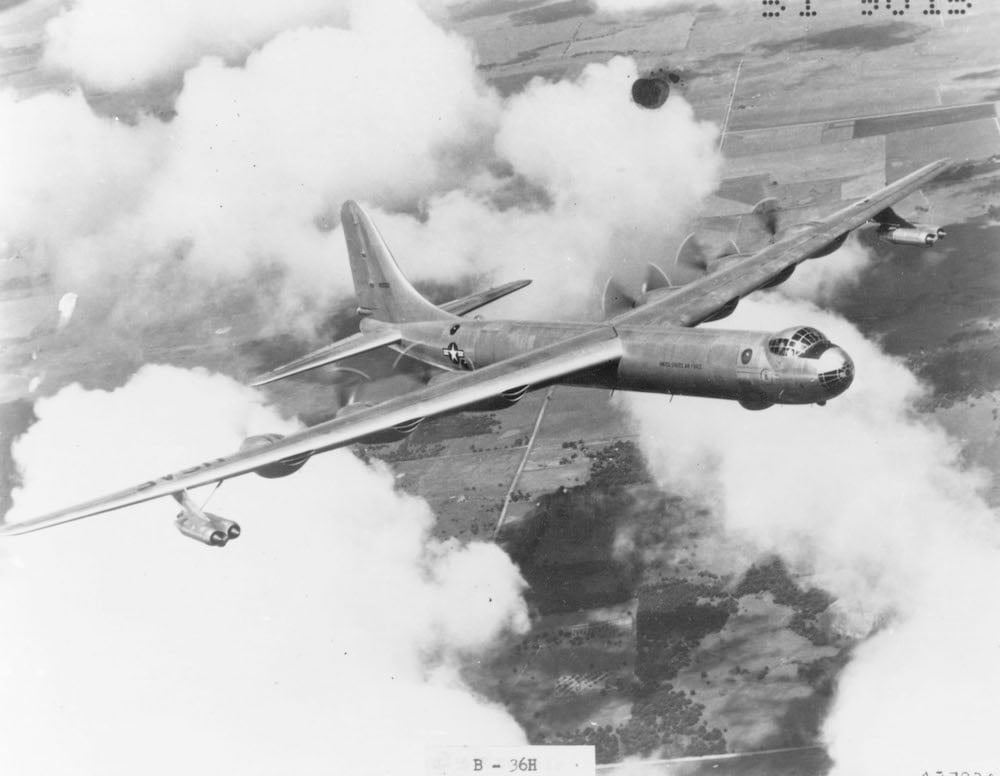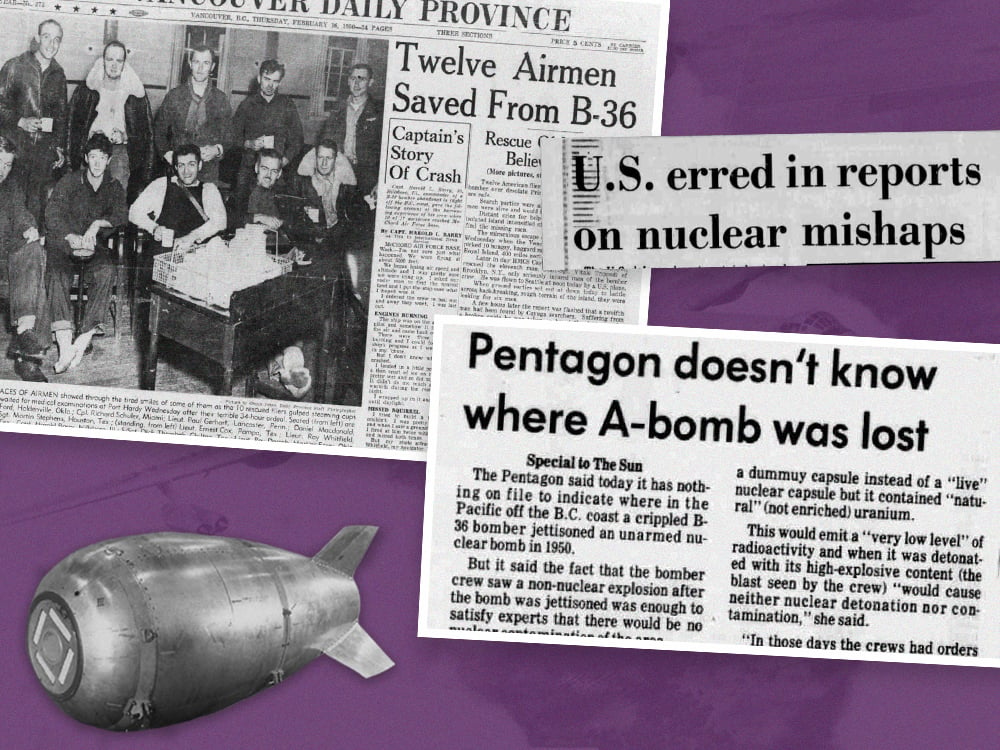It’s not every day the U.S. Air Force loses a nuclear warhead. But the first time it happened was somewhere over northwest B.C.
The night was bitterly cold and the B-36 bomber had taken off from a military airbase near Fairbanks, Alaska. It was 1950, the early days of the Cold War, and the aircraft was on a training run down the Alaska-B.C. coastline to San Francisco and eventually Texas.
The pilot had strict instructions not to enter Canadian airspace. But when three of the B-36’s six engines burst into flames somewhere over Hecate Strait, to the east of Haida Gwaii, he turned the vessel inland, giving the 17-person crew a chance to survive in the wilds of coastal B.C. rather than the frigid Pacific Ocean.
Just before midnight on Feb. 14, 1950, the crew bailed out, parachuting over the remote Princess Royal Island, southwest of Kitimat. A dozen survived and were rescued in the days that followed.
Some crew members described seeing the flaming aircraft arc overhead before making what was presumed to be its final descent into the sea somewhere off the west coast.
But the belly of the airplane also held a secret. It would take 30 years for the U.S. government to admit the aircraft had been carrying a Mark 4 atomic bomb, known as a “Fat Man” and similar to the one that was dropped on Nagasaki in 1945.
Officially, the bomb was unarmed. The Pentagon maintains it contained a “dummy” core rather than the plutonium one needed for a nuclear explosion. It says that when it was jettisoned and destroyed just prior to the crash, using conventional explosives, only a relatively small amount of radiation from its uranium casing scattered over the ocean.

Seventy years later, many details about Broken Arrow No. 1 — a reference to the U.S. code name for nuclear weapons incidents — remain classified.
Among the biggest mysteries is how the B-36 came to rest on the upper slopes of Mount Kologet, at nearly 2,000 metres elevation and more than 300 kilometres in the opposite direction from where it was last seen, apparently about to plunge into the sea.
Was the U.S. Air Force trying to hide something?
“Well, that’s the whole story,” chides Joy Allen from her home in the Kispiox Valley. “Who knows? It’s so intriguing.”
‘One engine on fire. Contemplating ditch’
Mount Kologet is located in the Kispiox Mountains, which extend north from Hazelton. Cold, desolate and often inaccessible, the resting place of Broken Arrow No. 1 is now protected under B.C.’s Heritage Conservation Act.
By comparison, the Kispiox Valley is lush and green this time of year. It’s where Joy Allen and her husband Gene grew up, raised their family and continue to manage a fly-fishing lodge on the shores of the meandering Kispiox River, roughly 50 kilometres south of the crash site.
Joy remembers first hearing about the B-36, and its potential for harbouring a missing nuke, while gathered around her in-laws’ dinner table decades ago.
“I just started asking questions,” she says. “It piqued my interest because nobody had really good answers.”
The bomber had taken off from Eielson Air Force Base on Feb. 13, 1950, with enough fuel to spend 24 hours in the air. But about six hours into the flight, it began to encounter engine trouble. Temperatures plunged to -40 C and the bomber was encased in ice. Shortly before midnight, a ham radio operator in the region reported hearing the pilot’s distress call.
“One engine on fire. Contemplating ditch in Queen Charlotte Sound,” it said. “Keep a careful lookout for flares or wreckage.”
The $6 million aircraft was “sinking like a stone,” Capt. Harold Barry later told the Vancouver Sun, dropping 3,000 metres in just 10 minutes. He testified at a U.S. Air Force inquiry that he had taken the bomber over water and ordered the co-pilot to hit the switch that would open the bomb bay doors.
At first, they didn’t open. He tried again. This time they released. Crew members reported seeing a flash of light as the Mark 4 exploded 1,500 metres above the ocean. Then Barry rang the alarm, telling the crew to evacuate.

“I was the last one out and I know for sure that all aboard got out by parachute. After I dropped I heard the plane above me going north. I had set the controls for a slow right turn to fly back to sea and to lose altitude,” Barry told the Sun.
But neither of those things happened. More than three years later, on Sept. 3, 1953, the actual crash site was discovered by the Royal Canadian Air Force while it was searching for another lost airplane north of Smithers.
The U.S. Air Force visited the site in August 1954. They were guided on horseback by Gene Allen’s uncles, Jack Lee and Bill Love. Aircraft staging out of Smithers dropped supplies for the highly secretive mission, including a Geiger counter to measure radioactivity, and explosives to destroy the B-36 and bury the debris.
It’s unclear what the team found once they got there. Non-military visitors, such as guides Lee and Love, were required to keep their distance.
“They weren’t allowed to go into the actual crash site itself. They had to stay back with the horses and one of the guys stayed back with them to make sure that they didn’t go in there,” Joy Allen says.
“It might have been for their own protection.”
To this day, the U.S. government has said little about the recovery mission. But human remains and the bomb’s plutonium core are among things some speculate could have been removed from the site.
Many believe that the only plausible explanation for the B-36 landing, largely intact, on a snowfield just below an upper ridge on Mount Kologet is that someone was piloting it.
A missing weaponeer
Capt. Ted Schreier was among five crew members never found in the extensive land and air search following the incident. He was third pilot, capable of flying the massive aircraft, and as weaponeer was responsible for the atomic bomb. According to aviation historian Dirk Septer, author of Lost Nuke, conflicting survivor testimony later demonstrated confusion about when Schreier actually exited the plane.
“If Schreier had stayed on board, what was he trying to save? What was worth risking his life for?” Septer writes. “Certainly not the aircraft; there must have been something else.”
While official reports maintain that no bodies were found at the crash site, Septer reports that a declassified government document describes “the body of one crewman in the wreckage.”
In a March 1987 letter to the Vancouver Sun, D.G. Bell-Irving, a wing commander with the Royal Canadian Air Force who led the initial search in February 1950, also maintained that one person did not bail out. “His body was found in the wreck of the aircraft, many years later and a considerable distance inland,” he wrote.
“In 1950 we were not told of the B-36’s armament,” Bell-Irving added. “The reticence of the United States authorities at that time is now understandable. (They never even said thank you.)”
It wasn’t until 1981 that the U.S. government came clean about the nuclear weapon on board the B-36.
It released the information in a summary of nuclear weapons incidents from 1950 to 1980, starting with No. 1, the lost bomber that had been on a “simulated combat profile mission” off the B.C. coast.
But why the secrecy? For some, the obvious explanation is that the B-36 was still carrying the A-bomb’s highly radioactive, baseball-sized plutonium core — integral to the chain reaction that would cause a nuclear explosion.
In August 1997, concerns over potential radiation prompted the Department of National Defence and Environment Canada to visit the site. It was the first visit since a Geological Survey of Canada expedition stumbled across the wreck in 1956. The team discovered massive amounts of unused ammunition and explosives, both from the original wreck and the 1954 expedition to, literally, cover it up. But they reported no elevated levels of radiation.
The trip opened the site to looting.
By the time a team of researchers visited in August 2003 to film the documentary Lost Nuke, the snowfield surrounding the B-36 had receded, leaving more of the wreck exposed. Most of what had been above the snow in 1954 had been destroyed by the U.S. Air Force, with a focus on the compartment that held the Mark 4. The bomb bay was reduced to “a pool of aluminium blobs,” wrote Canadian nuclear historian John Clearwater.
Many of the artifacts that had been exposed were taken. In online journal entries, Clearwater described his heartbreak at finding the site stripped of its cultural heritage.
“No one before my team has ever had a licence to recover artifacts from this crash site,” he wrote. “Everything prior to this was just theft. Even the Canadian Forces has taken stuff.”
In an email to The Tyee, B.C.’s Ministry of Forests confirmed that the Broken Arrow site, like all airplane and shipwrecks that are more than two years old, is automatically protected under the Heritage Conservation Act. As such, it’s illegal to alter it without a permit.
The only permit ever issued for the site was Clearwater’s, it added.
In addition to changes to natural resource management a decade ago that gave the province more power to enforce the Heritage Conservation Act, the ministry says efforts are underway to update the act for the first time since the mid-1990s. Initiated in 2019, the changes largely focus on aligning the legislation with the Declaration on the Rights of Indigenous Peoples Act.
“Looting is a serious issue and can be extraordinarily hard to prove and prosecute,” a spokesperson wrote. They referred questions about theft from the Broken Arrow site to the RCMP.
One group, from Terrace, formed the Broken Arrow Aircraft Society in 1998 in an effort to legitimize their salvage expeditions. With support from city council, they envisioned a permanent display. But a museum never materialized and the society was dissolved in 2005.
The artifacts became scattered throughout the region. Some are housed by the Stewart Historical Society and the Bulkley Valley Museum in Smithers. Others remain in private collections, while some are reported to have been sold online.
At least one artifact made its way back to the U.S.
The “bird cage,” a lead carrying case for the plutonium core, was removed in 1998. According to Septer, “It was not only illegal to remove this important atomic artifact, it was also unknown at the time whether the container might still contain a deadly plutonium core.”
The bird cage’s disappearance is documented in a 2004 Geological Survey of Canada article by Jim Roddick, who led the survey team that stumbled across the site in 1956. Roddick had returned to the site with American Scott Deaver and the team loaded the bird cage onto a helicopter and flew it out.
“We were a bit worried that the helicopter pilot would question us about our odd-looking freight,” Roddick wrote. But the team successfully removed the artifact and Deaver drove it across the U.S. border, describing it to customs agents as “a piece of plane wreckage, destined for a museum.”
Once home in Connecticut, Deaver opened the case. He found it “gleaming and pristine inside, but empty,” according to Roddick.
Mysteries remain
While interest in Broken Arrow No. 1 has persisted, so has the secrecy surrounding it.
In the late 1990s, Joy Allen’s curiosity led her to plan what would have been a gruelling, weeklong pack trip into the site. But when she began making inquiries about its location, she was “stonewalled,” first by the Canadian government and then the U.S. Air Force.
When she asked a military friend in Texas for help, government officials showed up at his door, demanding to know his interest in the site, she says.
“Nobody wanted to give us coordinates,” Joy says. “It was such a top-secret thing.”
In the end, she abandoned the trip.
Broken Arrow No. 1 was just the first of dozens of nuclear weapons incidents.
While some details about the night it went down remain classified, one thing appears certain: if the B-36 really had been carrying the plutonium core — and if Capt. Schreier had indeed stayed with the aircraft in an attempt to usher it to safety — the Pentagon is unlikely to talk about it. ![]()
Read more: Transportation


















Tyee Commenting Guidelines
Comments that violate guidelines risk being deleted, and violations may result in a temporary or permanent user ban. Maintain the spirit of good conversation to stay in the discussion and be patient with moderators. Comments are reviewed regularly but not in real time.
Do:
Do not: